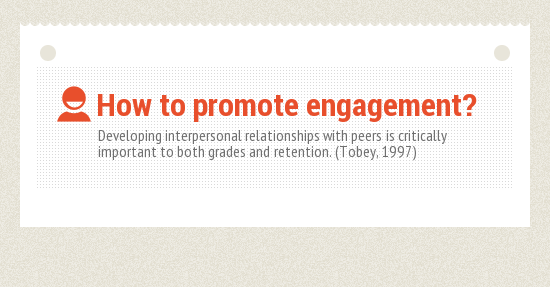
By: Tara Tressel
Defining student engagement might seem like a trivial task. How hard could it be, right? A student that is engaged is a student that cares about their learning. Done.
The truth, though, is that student engagement is quite a complex concept; one that has grown to envelop many varying factors that have different bearings on how we deal with this term. Such factors include: socioeconomic status, student-teacher relationship, the structure and culture of the institution, and the motivations of the student5. And, unfortunately, it is also a concept that is in danger of becoming an empty catch phrase or slogan due to the broad, generalized use and measurement of the term1. Inspired by an article1 that exhorts stepping outside of the typical perspectives of student engagement, I will use this post to clarify what, in a practical sense, student engagement actually means and how we need to think about it.
In research, student engagement is frequently described as a predictive variable of academic achievement (the more engaged a student is, the better they will perform in school)3. In this representation, which follows the definition of education in a traditional sense, engagement is discussed as a behavioral occurrence; i.e., the engaged student performs actions such as putting forth effort into their classes and homework1.
Chapman (2003) offers another possible definition - “students’ cognitive investment in, active participation in, and emotional commitment to their learning”1. This definition looks at engagement in more flexible terms.
Taken together, we are left with a comprehensive definition that better suits the needs of modern education. If we look beyond the traditional perspective, the purpose of schooling incorporates more learning outcomes than just academic achievement. Learning experiences in other domains, such as: social, artistic, vocational, personal, intellectual, and kinesthetic, contribute greatly to strengthening student development, and are equally as important as academic achievement when considering engagement1. Just look at how most North American schools are already teaching 21st century skills, which include critical thinking, creativity, innovation, and working collaboratively with others. We are seeing a shift in focus to include not only academic achievement but also a broader sense of learning and development. This is why we need such a comprehensive definition of student engagement.
But there is yet another important element to this equation that must be explored: a student does not live inside a vacuum. Research suggests that in order for a student to connect to their school environment, key members of that environment (administrators and teachers, for example) must be engaged as well2.
Additionally, students who experience a sense of community amongst their peers also tend to find a sense of belonging within their institution1. Student engagement is, then, not only a disposition towards learning within one individual, but all individuals involved.
Finding tools that support the many facets of student engagement, as well as considering the many layers of individuals contributing to this concept, can be challenging. OOHLALA campus mobile app targets this disposition by connecting the individual student with:
- Other students in their classes by encouraging collaboration through study sessions and meetups
-Campus services, departments, and administration, made easily accessible (1-click to call or email) through the campus directory
-Campus-wide peer meetups through augmented-reality games, clubs, and campus wall communication
It is imperative that we harness student engagement in a comprehensive means and tools like OOHLALA are necessary to achieve this goal. OOHLALA’s group-oriented approach brings together peers and administrators, which is crucial to fostering a deeper sense of engagement.
How do you promote engagement in your school? What is your experience as a student or administrator with staying engaged with your institution?
Citations:
1. McMahon, B., & Portelli, J. P. (2004). Engagement for what? Beyond popular discourses of student engagement. Leadership and Policy in Schools, 3(1), 59-76.
2. Smith, W., Butler-Kisber, L., LaRocque, L., Portelli, J., Shields, C., Sparkes, C., & Vibert, A.
(1998). Student engagement in learning and life: National Project Report. Montreal:
Office of Research on Educational Policy, McGill University
3. Steinberg, L. (1996). Beyond the classroom: Why school reform has failed and what parents
need to do. New York: Touchstone.
4. Zepke, N., & Leach, L. (2010). Improving student engagement: Ten proposals for action. Active Learning in Higher Education, 11(3), 167-177.

No comments:
Post a Comment